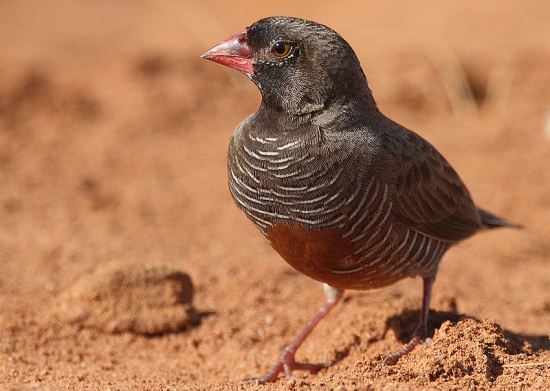Includes: Black-faced Quailfinch; Black-chinned Quailfinch; African Quailfinch
- Ortygospiza atricollis
Identification
Length 9.5-10 cm, mass 8-14 g. Very small, with short tail.
Males
- Greyish-brown upperparts
- White barring on chest and flanks
- Black facial mask
- Some subspecies has white chin and/or white spectacles around the eyes
- Red bill when breeding
- Pinkish legs
- Long hind claw
Females lack the facial mask and are duller.
Juveniles similar to the female but have fainter barring and a darker bill.
Usually located and identified by repeated djink flight call. The absence of red or orange on the rump distinguishes it from Locustfinch and Orange-breasted Waxbill.
Distribution
Patchy distribution throughout most of Africa south of Sahara.
Taxonomy
Elleven subspecies are recognized[1].
- O. a. atricollis:
- O. a. ansorgei:
- Guinea-Bissau to Liberia, Ivory Coast and coastal Ghana
- Guinea-Bissau to Liberia, Ivory Coast and coastal Ghana
- O. a. ugandae:
- O. g. gabonensis
- O. g. fuscata
- O. g. dorsostriata
- O. f. fuscocrissa:
- O. f. muelleri (bradfieldi, miniscula):
- Kenya to Zambia, Angola, Namibia, north central South Africa
- O. f. smithersi:
- North-eastern Zambia
- O. f. pallida:
- O. f. digressa:
- Eastern Zimbabwe, southern Mozambique, South Africa, Lesotho, eSwatini
The subspecies included here were previously considered three different species: Black-faced Quailfinch (first three subspecies), Black-chinned Quailfinch (next three subspecies), and African Quailfinch (last five subspecies).
Habitat
Open areas with patchy grass growth, near water, sandy grassland, marsh, farms and croplands, and recently mowed areas. Mostly lowland to hills, reaches 2700 m asl in Ethiopia. White-chinned subspecies usually prefer dryer habitats.
Behaviour
Diet
The diet includes small grass seeds and some spiders or insects. Feeding birds might be alone or in flocks of up to 20.
Breeding
A dome-shaped nest of grass stems and blades is built on the ground. The clutch consists of 4-6 white eggs which are incubated by both parents.
Vocalisation
The call is a metallic djink, trillink or chwillink (often given in flight), and the song is a series of click, clack, cluck notes delivered rapidly and repeatedly.
References
- Clements, J. F., T. S. Schulenberg, M. J. Iliff, S. M. Billerman, T. A. Fredericks, B. L. Sullivan, and C. L. Wood. 2019. The eBird/Clements Checklist of Birds of the World: v2019. Downloaded from http://www.birds.cornell.edu/clementschecklist/download/
- Gill F, D Donsker & P Rasmussen (Eds). 2021. IOC World Bird List (v11.1). doi : 10.14344/IOC.ML.11.1. http://www.worldbirdnames.org/
- Hockey, PAR, WRJ Dean, and PG Ryan, eds. 2005. Roberts' Birds of Southern Africa. 7th ed. Cape Town: John Voelcker Bird Book Fund. ISBN 978-0620340533
- Payne, R. B. (2020). Quailfinch (Ortygospiza atricollis), version 1.0. In Birds of the World (J. del Hoyo, A. Elliott, J. Sargatal, D. A. Christie, and E. de Juana, Editors). Cornell Lab of Ornithology, Ithaca, NY, USA. https://doi.org/10.2173/bow.quailf1.01
Recommended Citation
- BirdForum Opus contributors. (2024) Quailfinch. In: BirdForum, the forum for wild birds and birding. Retrieved 25 April 2024 from https://www.birdforum.net/opus/Quailfinch






